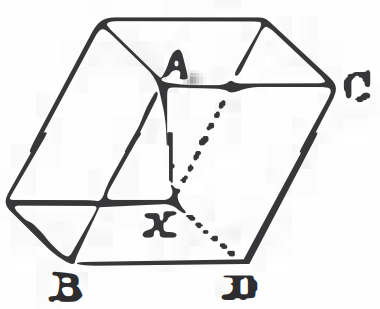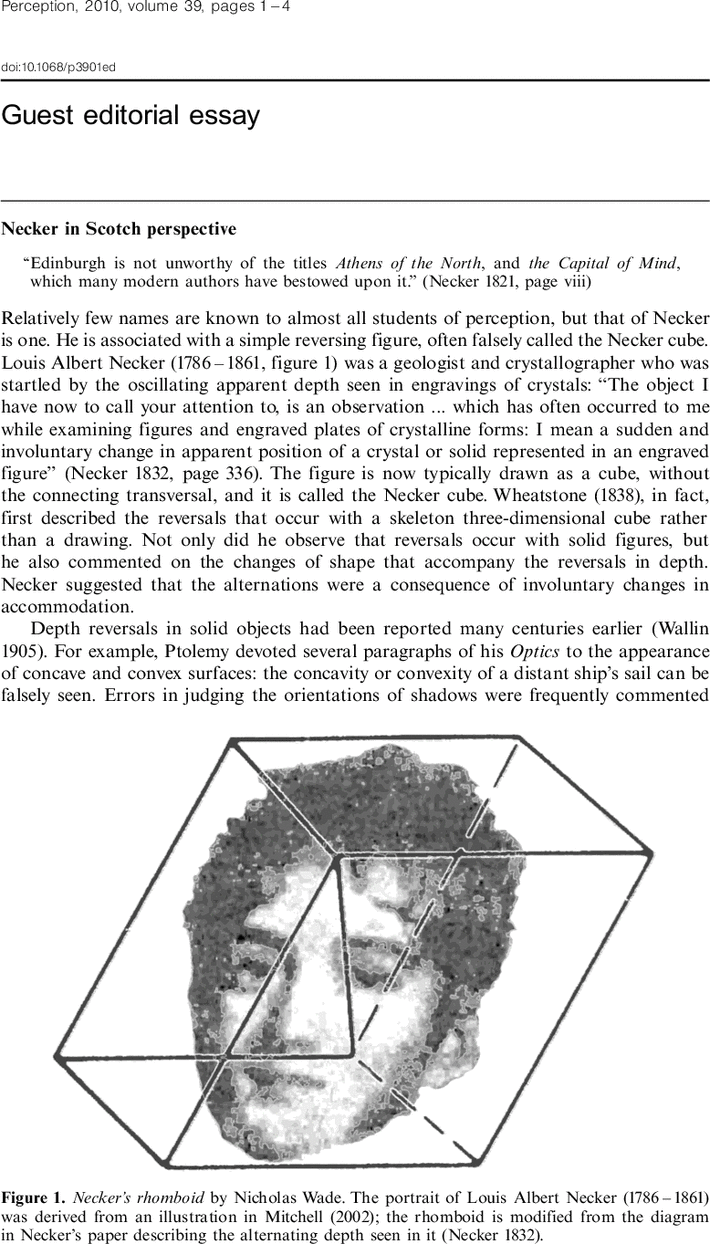- The interpretation of the percept oscillates diachronically (across time).
- The Necker cube can be modeled as a bistable binary state (0,1).
- Quantum models have been developed to predict the time period between oscillations and how these periods change with frequency of measurement (see Quantum Zeno Effect).
The “Necker cube” was first published by the Swiss Louis Albert Necker in 1932 and is eponymously named after him. He described its geometric features in the context of crystal drawings. The original article is available here.

First description of the “Necker cube” by Prof. Necker in his original publication in 1832.
“The object I have now to call your attention to, is an observation which is also of an optical nature, and which has often occurred to me while examining figures and engraved plates of crystalline forms: I mean a sudden and involuntary change in the apparent position of a crystal or solid represented in an engraved figure. What I mean will be more easily understood from the figure annexed.
How wonderful that we have met with a paradox. Now we have some hope of making progress.As quoted in
Niels Bohr as quoted in ‘Nils Bohr, The Man, His Science, & the World They Changed’ (1966) by Ruth Moore, p. 196
Necker went on:
“The object I have now to call your attention to, is an observation which is also of an optical nature, and which has often occurred to me while examining figures and engraved plates of crystalline forms{I} A crystal or crystalline solid is a solid material whose constituents are arranged in a highly ordered microscopic structure. : I mean a sudden and involuntary change in the apparent position of a crystal or solid represented in an engraved figure. What I mean will be more easily understood from the figure annexed.
The rhomboid AX is drawn so that the solid angle A should be seen the nearest to the spectator, and the solid angle X the furthest from him, and that the face ACBD should be the foremost, while the face XDC is behind. But in looking repeatedly at the same figure, you will perceive that at times the apparent position of the rhomboid is so changed that the solid angle X will appear the nearest, and the solid angle A the furthest; and the the face ACDB will recede behind the face XDC, which will come forward; which effect gives to the whole-solid a quite contrary apparent inclination. I have been a long time at a loss to understand the reason of the apparently accidental and involuntary change which I always witnessed in all sorts of forms in books of crystallography. The only thing I could observe was, that at the time the change took place, a particular sensation was felt in the eye (for it takes place as well when seen with only one eye, as with both eyes), which proved to me that it was an optical, and not merely as I had at first thought a mental, operation which was performed.” (Necker, 1932, p.336)
Prof. Necker thus thought that bistable perception was caused by small adjustments of the eye (saccades) and not by higher-order cognitive processes. The importance of eye-position and movement is still a topic in psychophysics. For instance, Einhäuser, Martin, & König (2004) argued that “the average eye position of most subjects is at an extreme value at about the time when the subject’s perception switches“. Furthermore, the researchers argue that “These data indicate a bidirectional coupling between eye position and perceptual switching so that, after a subject’s perceptual state changes, their eye position shifts to view the newly established percept“.
The quantum cognition perspective on the Necker cube provides a very different level of explanation (see references below).
Plain numerical DOI: 10.1111/j.1460-9568.2004.03722.x
DOI URL
directSciHub download
Show/hide publication abstract
See also: Hollier, J., Hollier, A., & Schnyder, C. (2015). The publications and collections of Louis-Albert Necker (1786-1861). Archives of Natural History. https://doi.org/10.3366/anh.2015.0279
Wade, N. J., Campbell, R. N., Ross, H. E., & Lingelbach, B. (2010). Necker in Scotch perspective. Perception. https://doi.org/10.1068/p3901ed

References
- Atmanspacher, H., Filk, T., Römer, H. (2004). Quantum zeno features of bi-stable perception. Biological Cybernetics, 90, 33-40.
- Atmanspacher, H., Filk, T., Römer, H. (2009) Complementarity in Bistable Perception, Recasting Reality, pp. 135‐150. Berlin: Springer
-
Atmanspacher, H., & Filk, T. (2010). A proposed test of temporal nonlocality in bistable perception. Journal of Mathematical Psychology, 54(3), 314 – 321.
-
Atmanspacher, H., & Filk, T. (2013). The Necker-Zeno model for bistable perception. Topics in Cognitive Science, 5(4), 800–817.
-
Conte, E., Khrennikov, A., Todarello, O., Federici, A., Zbilut, J. P. (2009). Mental states follow quantum mechanics during perception and cognition of ambiguous figures. Open Systems and Information Dynamics, 16, 1-17.
Footnotes
| I. | ↥ | A crystal or crystalline solid is a solid material whose constituents are arranged in a highly ordered microscopic structure. |




